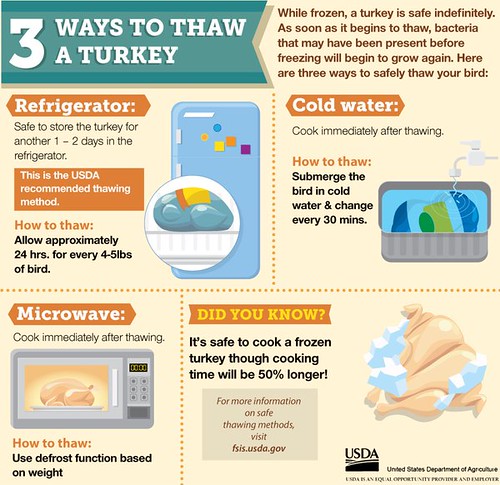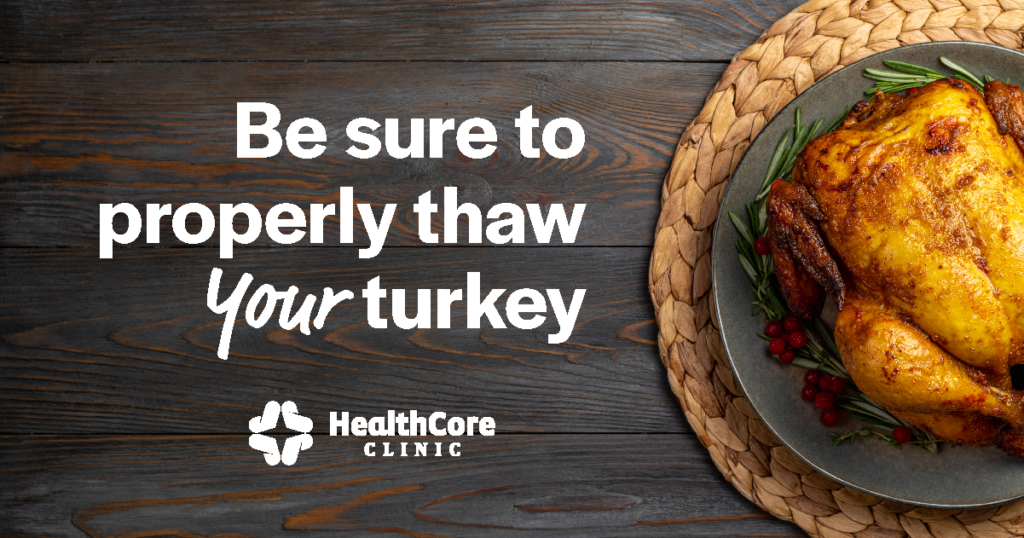How to Safely Thaw a Turkey
Nov 23, 2022
While frozen, a turkey is safe for an indefinite period of time. However, as soon as it begins to thaw, bacteria that may have been present before freezing will begin to grow again. There are three safe ways to defrost a turkey: in the refrigerator, in cold water, and in a microwave oven.

Refrigerator Thawing (Recommended)
The USDA recommends thawing your turkey in the refrigerator. This is the safest method because the turkey will thaw at a consistent, safe temperature. This method takes some time, so allow one day for each 4 – 5 pounds of weight. If your turkey weighs 16 pounds, it will take about four days to thaw. Once thawed, the turkey is safe for another two days, so you can start thawing it six days before thanksgiving (the Friday before Thanksgiving).
Allow approximately 24 hours of thawing for every 4 to 5 pounds
- 4 to 12 pounds: 1 to 3 days
- 12 to 16 pounds: 3 to 4 days
- 16 to 20 pounds: 4 to 5 days
- 20 to 24 pounds: 5 to 6 days
Keep the turkey in its original wrapper. Place it on a tray or in a pan to catch any juices that may leak. A thawed turkey can remain in the refrigerator for 1 to 2 days. If necessary, a turkey that has been properly thawed in the refrigerator may be refrozen.
The other two methods (cold water and microwave) must be done immediately before you start cooking the turkey, so you’ll have to wait until Thanksgiving morning.
Cold Water Thawing
For the cold water method, leave the turkey in its original wrapping and submerge it in a sink (or container) full of cold water. It is important that the water be cold so that the turkey stays at a safe temperature. You should change the water every 30 minutes. Empty out the water and replace it with fresh cold water. With this method, allow 30 minutes of defrosting time per pound, so a 16-pound turkey will take 8 hours to thaw using this method (so you might need to start around 4 AM if you want to eat in the afternoon!).
Allow approximately 30 minutes of thawing per pound
- 4 to 12 pounds: 2 to 6 hours
- 12 to 16 pounds: 6 to 8 hours
- 16 to 20 pounds: 8 to 10 hours
- 20 to 24 pounds: 10 to 12 hours
Once the turkey has thawed, cook it immediately. Wrap your turkey securely, making sure the water is not able to leak through the wrapping. Submerge your wrapped turkey in cold tap water. Change the water every 30 minutes. Cook the turkey immediately after it is thawed. Do not refreeze.
Microwave Thawing
Before you commit to thawing your turkey in the microwave, check your owner’s manual for the size of turkey that will fit in your microwave oven, the minutes per pound, and the power level to use when thawing a turkey. Remove all outside wrapping and place the turkey on a microwave-safe dish to catch any juices that may leak. Use the defrost function based on weight. As a general rule, allow 6 minutes per pound when thawing a turkey in the microwave. Be sure to rotate it several times, and even flip it, during the thawing process.
If the turkey starts to actually cook instead of just defrosting, let it rest for 5 minutes or so before you resume thawing. Partway through thawing, you may wish to cover the tips of the wings and drumsticks with a small piece of foil to shield them from the microwaves and keep them from cooking. Once the turkey has thawed you should cook it immediately.

How NOT to Thaw a Turkey
In case you are wondering, here are some thawing methods that are not recommended:
- Thawing a turkey on the counter, in the garage, or on the back porch.
- Thawing a turkey in a brown paper grocery bag or plastic garbage bag.
- Using the dishwasher to thaw a turkey (with or without water).
- Any method that is not the refrigerator, cold water, or microwave.
How to Cook a Frozen Turkey
If your turkey is still icy on Thanksgiving morning, don’t panic! It is perfectly safe to cook a turkey from a frozen state; it will just take longer to cook. A solidly frozen turkey will take at least 50 percent longer to cook than a thawed turkey. If your turkey is only partially frozen, remember that it will take a bit longer to cook. Use your food thermometer, and when your bird measures 165˚F in the innermost part of the thigh, the innermost part of the wing, and the thickest part of the breast, it is ready.
Roasting Your Turkey
- Set your oven temperature no lower than 325 °F.
- Place your turkey or turkey breast on a rack in a shallow roasting pan.
- For optimum safety, stuffing a turkey is not recommended. For more even cooking, it is recommended you cook your stuffing outside the bird in a casserole. Use a food thermometer to check the internal temperature of the stuffing. The stuffing must reach a safe minimum internal temperature of 165 °F.
- If you choose to stuff your turkey, the ingredients can be prepared ahead of time; however, keep wet and dry ingredients separate. Chill all of the wet ingredients (butter/margarine, cooked celery and onions, broth, etc.). Mix wet and dry ingredients just before filling the turkey cavities. Fill the cavities loosely. Cook the turkey immediately. Use a food thermometer to make sure the center of the stuffing reaches a safe minimum internal temperature of 165 °F.
- A whole turkey is safe when cooked to a minimum internal temperature of 165 °F as measured with a food thermometer. Check the internal temperature in the innermost part of the thigh and wing and the thickest part of the breast. For reasons of personal preference, consumers may choose to cook turkey to higher temperatures.
- If your turkey has a “pop-up” temperature indicator, it is recommended that you also check the internal temperature of the turkey in the innermost part of the thigh and wing and the thickest part of the breast with a food thermometer. The minimum internal temperature should reach 165 °F for safety.
- For quality, let the turkey stand for 20 minutes before carving to allow juices to set. The turkey will carve more easily.
- Remove all stuffing from the turkey cavities.
Timetables for Turkey Roasting (325 °F oven temperature)
Use the timetables below to determine how long to cook your turkey. These times are approximate. Always use a food thermometer to check the internal temperature of your turkey and stuffing.
Unstuffed
- 4 to 8 pounds (breast): 1½ to 3¼ hours
- 8 to 12 pounds: 2¾ to 3 hours
- 12 to 14 pounds: 3 to 3¾ hours
- 14 to 18 pounds: 3¾ to 4¼ hours
- 18 to 20 pounds: 4¼ to 4½ hours
- 20 to 24 pounds: 4½ a 5 hours
Stuffed
- 4 to 6 pounds (breast): Not usually applicable
- 6 to 8 pounds (breast): 2½ to 3½ hours
- 8 to 12 pounds: 3 to 3½ hours
- 12 to 14 pounds: 3½ to 4 hours
- 14 to 18 pounds: 4 to 4¼ hours
- 18 to 20 pounds: 4¼ to 4¾ hours
- 20 to 24 pounds: 4¾ to 5¼ hours
It is safe to cook a turkey from the frozen state. The cooking time will take at least 50 percent longer than recommended for a fully thawed turkey. Remember to remove the giblet packages during the cooking time. Remove carefully with tongs or a fork.
Storing Your Leftovers
- Discard any turkey, stuffing, and gravy left out at room temperature longer than 2 hours; 1 hour in temperatures above 90 °F.
- Divide leftovers into smaller portions. Refrigerate or freeze in covered shallow containers for quicker cooling.
- Use refrigerated turkey, stuffing, and gravy within 3 to 4 days.
- If freezing leftovers, use within 2 to 6 months for best quality.
Reheating Your Turkey
Cooked turkey may be eaten cold or reheated.
In the Oven
- Set the oven temperature to no lower than 325 °F.
- Reheat the turkey to an internal temperature of 165 °F. Use a food thermometer to check the internal temperature.
- To keep the turkey moist, add a little broth or water and cover.
In the Microwave Oven
- Cover your food and rotate it for even heating. Allow standing time.
- Check the internal temperature of your food with a food thermometer to make sure it reaches 165 °F.
- Consult your microwave oven owner’s manual for recommended times and power levels.
_____
This is information was reposted from the USDA. For more information on safe thawing methods, and to read the original article, visit usda.gov/media/blog/2016/11/18/how-safely-thaw-turkey.